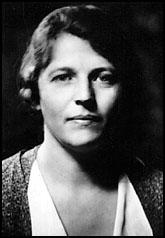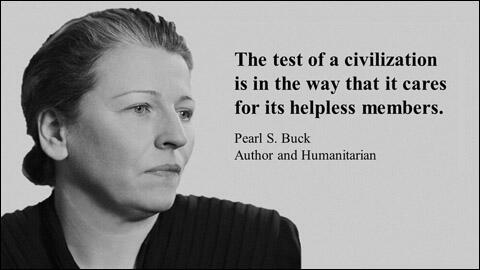Pearl Buck

Pearl Buck (Sydenstricker) was born in Hillsboro, West Virginia on 26th June, 1892. The daughter of Presbyterian missionaries, Absalom Sydenstricker (1852-1931) and Caroline Stulting (1857–1921), was raised in Zhenjiang.
Buck returned to the United States in 1911 and studied at Randolph-Macon Woman's College. Buck developed left-wing political views at university and was a strong supporter of women's suffrage.
In 1914 Buck returned to China and three years later married an agricultural economist missionary, John Lossing Buck. The couple moved to Suzhou, a small town on the Huai River.
In 1920 the Bucks moved to Nanjing. Pearl taught English Literature at Nanjing University and the Chinese National University. In 1924, they returned to the United States where Pearl earned her Masters degree from Cornell University. The following year they returned to China.
Pearl Buck's first novel, East Wind: West Wind, was published in 1930. This was followed by the highly successful The Good Earth (1931). It won the Pulitzer Prize "for her rich and truly epic descriptions of peasant life in China". It also inspired a Broadway play and an award-winning film.
In 1934, the Bucks moved back to the United States. The following year she divorced John Lossing Buck and married Richard Walsh, the president of the John Day Company and her publisher. In 1935, she bought a sixty-acre homestead she called Green Hills Farm in Pennsylvania and moved into the one hundred year-old farmhouse on the property with her second husband and their family of six children. Pearl Buck continued to write novels and this included The Mother (1934), House of Earth (1935), The Exile (1936), Fighting Angel (1936) and The Proud Heart (1938).
Buck was a strong advocate of women's rights and wrote essays such as Of Men and Women (1941) and American Unity and Asia (1942) where she warned that racist and sexist attitudes would damage long-term prospects of peace in Asia. She also helped left-wing writers, Edgar Snow, Agnes Smedley and Anna Louise Strong reach American audiences.

After the Second World War Buck became a strong critic of American foreign policy. Robert Shaffer has argued: "Buck's early writings portrayed the subordination of Chinese women, but by the late 1930s she was also highly critical of formal and informal discrimination against women in the United States. While consistantly critical of Stalinism, Buck was an early opponent of the Cold War and of the American military build-up in the late 1940s, warning of American tendencies toward fascism." Buck also advocated recognition of the People's Republic of China and opposed U.S. policy in the Korean War.
Other novels by Buck included Dragon Seed (1942), Townsman (1945), Pavilion of Women (1946), A Long Love (1949), God's Men (1951), The Hidden Flower (1952), Come, My Beloved (1953), Imperial Women (1956), Letter from Peking (1957), Command the Morning (1959), The Living Reed (1963), Death in the Castle (1965), The Time Is Noon (1966), The New Year (1968), The Three Daughters of Madame Liang (1969) and Mandala (1970).
Pearl Buck died of lung cancer in Danby, Vermont, on 6th March, 1973.
Primary Sources
(1) Claudia FitzHerbert, The Daily Telegraph (27th March, 2010)
Pearl Buck was American by birth but entirely Chinese by upbringing. A mission daughter born in 1892, she graduated to being an unhappily married mission wife and mother. The runaway success of her second novel, The Good Earth (1931), altered her life. She swapped China for the United States and her agrarian economist husband for her New York publisher. Her fiction continued to be set in Asia and to borrow from iconoclastic younger novelists in China producing richly plotted popular fiction in the previously despised vernacular. Buck took this one step further by writing about the agrarian poor. A Pulitzer and Nobel Prize followed.
The New York Times recently wrote that “in China (Buck) is admired but not read and in America she is read but not admired”. “Both views could do with reappraisal,” suggests Hilary Spurling. Her compelling examination of the imaginative sources of Buck’s fiction succeeds triumphantly in this aim.
Spurling describes a writer who delivers both halves of the injunction to make the familiar strange and the strange familiar. In middle age, Buck remembered home as “a small decrepit brick bungalow with sagging floors full of centipedes and scorpions” in a city in south-western China. A small blue cloth-bound set of Dickens sat on a shelf in the sitting room that she could reach with a childish arm, title unseen. She soon knew the oeuvre well enough to find that any volume opened at random would deliver the required fix: “He was almost the sole access I had to my own people? I went to his parties for I had no other.”

